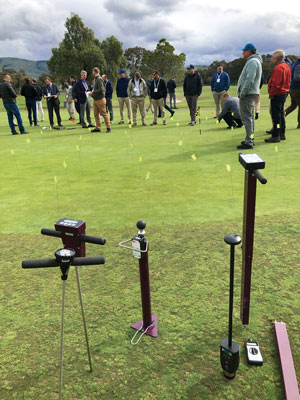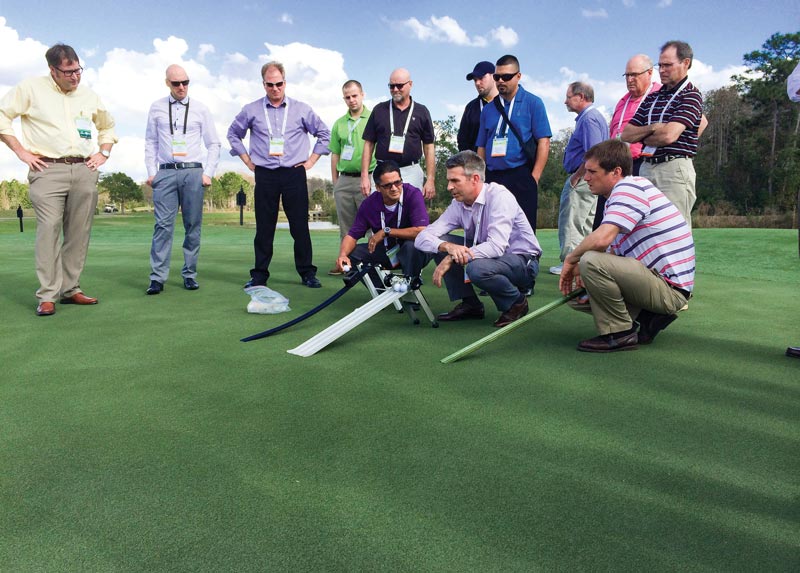First things first — what the heck is “What the Tech?”
Not to belabor the obvious, but “What the Tech?” is a new regular feature in GCM that will explore practical tools and technology related to golf course management. Since 2009, we have been presenting this type of information in our “Gadgets and Gizmos” seminar at the Golf Industry Show and at chapter meetings around the world. We have especially enjoyed getting to know many of you while playing with our toys at a golf facility near the convention center where GIS is taking place.

Right: Participants in the “Gadgets and Gizmos” seminar at the 2019 Golf Industry Show in San Diego had the opportunity to engage with several high-tech devices, including moisture meters. Photo by Scott Hollister
Our biggest challenge with the seminar is updating content each year as useful technology continuously develops. Therefore, we thought it would be worthwhile — and fun — to periodically publish an article in GCM that focuses on a single technology that is either new or particularly impactful to our industry. Hence, “What the Tech?”
Moisture meters
This first article is dedicated to moisture meter technology. These gadgets have been the cornerstone of our seminars, because they are easy to use and have a positive impact on putting green health and hand-watering efficiency. In fact, these meters were responsible for the development of the “Gadgets and Gizmos” seminar. We had been using them to evaluate wetting agent research trials since the mid-2000s, and quickly realized how useful they could be in the hands of golf course superintendents. This got us thinking that there were probably many other research tools that had potential utility in golf course management, and wouldn’t it be fun to acquire as many of these gadgets as possible and play with them at the Golf Industry Show?
When we talk about moisture meters, what exactly are we referring to? These are meters such as time-domain reflectometers (TDR) that measure the dielectric constant of the soil to estimate its water content. Unless you’re a physicist, the only thing you need to know about a soil’s dielectric constant is that it is highly correlated to soil water content. Therefore, measuring a soil’s dielectric constant makes it possible to estimate soil water content accurately.
Moisture meters are portable and accurate, and they aren’t affected by minor fluctuations in root-zone salinity. Convenience and quality come with a price tag, however, as meters range from $1,000 to $2,500 depending on added features such as data logging, mapping and simultaneous measurement of other parameters, such as temperature and salinity. Don’t let sticker shock drive you away from embracing this technology, however, as return on investment is typically quick, especially at facilities that require regular hand watering.
Soil water potential vs. water content
The key to getting the most bang for your moisture meter buck is to calibrate it for your specific greens. We’re often asked, “What number should I be looking for on my meter?” Such a question is impossible to answer, because turf drought stress is related to the water potential of the root zone, not the water content.
Soil water potential is essentially the force required to move water from the soil into turf roots. This can be a confusing concept, because it often involves large negative values with unfamiliar units — “-1,000 kilopascals,” for example. What the heck is a negative kilopascal? A kilopascal is simply a metric unit of pressure and can be converted to pounds/square inch (psi), just as centimeters can be converted to inches.
Water potential values are negative because negative pressure (suction) is required to move water from soil pores into turf roots. This suction force is created by transpiration of water from turf leaves, and turf roots can “suck” water from soil pores with a force of up to -1,500 kilopascals. That is a suction greater than 200 psi, which is quite impressive.
The relationship between water content and water potential is affected by soil texture and organic matter content. Imagine sandy and clay loam root zones that are both at 20% water content. Turf growing in the sand would need very little suction to move water into its roots (water potential near zero), whereas most of the water in the clay loam soil would be contained in very small pores and require much greater suction for plant uptake (water potential approaching -1,500 kilopascals). At equivalent water contents, turf on the sandy root zone may be too wet while the turf on the clay loam root zone is wilting.
Water potential
The good news is that you can use your moisture meter to estimate your water potential with a simple calibration exercise. First, take several measurements shortly after a heavy rainfall or a thorough irrigation. These water content values will correspond to a field-capacity water potential — like having a full tank of gas.
Then, during a time of year when you can let things dry down a bit, take several measurements when you begin to see “wilt footprints.” These water content values will indicate when your greens are approaching wilting-point water potential — an empty gas tank. You now have a window in which to manage the moisture content in your greens.
Water content
Let’s take this a step further. Imagine you’ve completed this exercise, and the water content on your greens ranges from 5% to 20%. It is likely that you’ll decide that 20% is a bit too wet and soft for playability, and that you’d rather avoid approaching 5%, where the turf begins to wilt. So, you decide to maintain your greens between 7% and 17% water content to maximize plant health and playability.

Right: Checking trouble spots with a moisture reading in the early morning allows for precise hand watering and ideal root-zone moisture throughout the day. Photo by Doug Karcher
Now, here comes the big payoff. When measuring trouble spots during the morning, you and your staff will — with a little practice — become very good at estimating how many percentage points of water will be lost that day, based on the weather forecast. You can then quickly determine whether hand watering is required and, if so, precisely how much water to add to restore the trouble spot to 17% water content. This strategy has been a game changer in greens management over the past decade, resulting in less time spent chasing hot spots on summer afternoons, healthier turf, better playing conditions and, presumably, better nights of sleep for the golf course management team.
Rod length
Another frequently asked question about using moisture meters is, “What rod length should I use?” Measurement rods vary between 1.5 and 8.0 inches for the predominant moisture meters currently used in the golf industry. We think that a 2- to 4-inch rod is ideal for most turf situations, as this depth corresponds to where 90% of your root mass resides, even if you have some roots growing out of the bottom of your cup cutter sample. If you are working with a compromised root system — for example, Poa annua in August — a shorter, 1.5-inch rod may be warranted.
It’s important to remember two key items related to rod length. First, whenever you use a new rod length — or even a new meter — you must recalibrate to determine the ideal water content range that will correspond to good playability and turf health. Organic matter content changes with root-zone depth, and, therefore, so does the relationship between water content and water potential.
Second, you should not attempt to measure a shallow root-zone depth with a long rod by inserting only a portion of the rod into the surface. The meter will measure along the entire length of the rod, including any portion that is above the putting surface. Therefore, readings will be erroneously low and fluctuate greatly with changes in humidity near the putting surface.
We recently discovered that it’s possible to accurately measure putting green moisture content at shallow depths (0.5 or 1.0 inch) by using an adapter block to protect exposed rods and ensure consistent measurement depth, and by also applying a correction equation to meter values. These findings have been commercialized and are available as an add-on to the TDR 350 model (Spectrum Technologies).

The “Gadgets and Gizmos” seminar at the Golf Industry Show gives participants an up-close look at the latest in relevant technology. Here, attendees observe differences among golf ball roll evaluation devices. Author Doug Karcher is center in the front row. Photo by Mike Richardson
Although TDR-type moisture meters aren’t as new as most of the other items that will be presented in future “What the Tech?” articles, they remain extremely impactful. Many facilities have not yet invested in the technology — presumably because of the high upfront cost — but it is nevertheless rare to find a golf course superintendent who has buyer’s remorse from purchasing a meter. It is more common for a facility to invest in a second and third meter once their value becomes apparent. In addition to managing root-zone water, moisture meters are useful in troubleshooting drainage issues, evaluating wetting agent efficacy, conducting an irrigation audit or even assessing bunker conditions.
Moving forward with this column, we welcome input and suggestions from GCM readers. We regularly get great ideas for new items to present in “Gadgets and Gizmos” from superintendents in the audience. If anyone has discovered a new or unusual gadget or phone app that is valuable in managing their golf course, please shoot us a brief description in a direct message on Twitter to @ArkansasTurf.
Doug Karcher is a turfgrass soil specialist and professor, Mike Richardson is a professor, and Daniel O’Brien is a program technician in the Department of Horticulture at the University of Arkansas in Fayetteville, Ark.